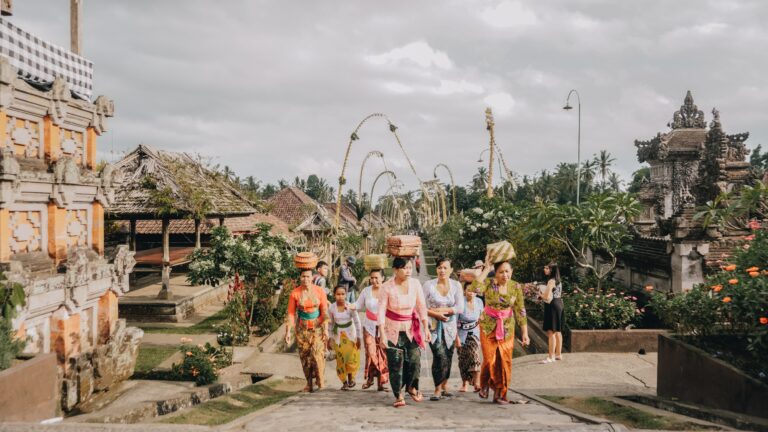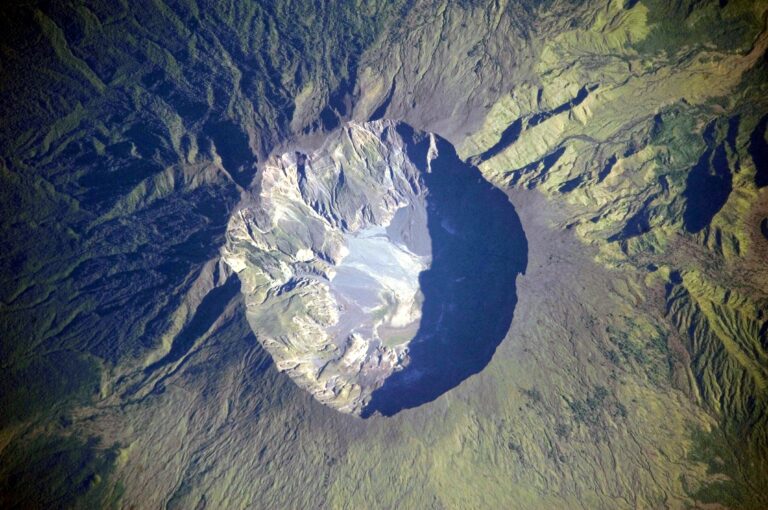Nestled on the lush island of Java, 40 kilometers away from Yogyakarta, the Borobudur Temple is a breathtaking marvel steeped in history. This ancient marvel, built during the 9th century, remains one of the most captivating Buddhist monuments in the world. Let’s embark on a journey to uncover the wonders of Borobudur.
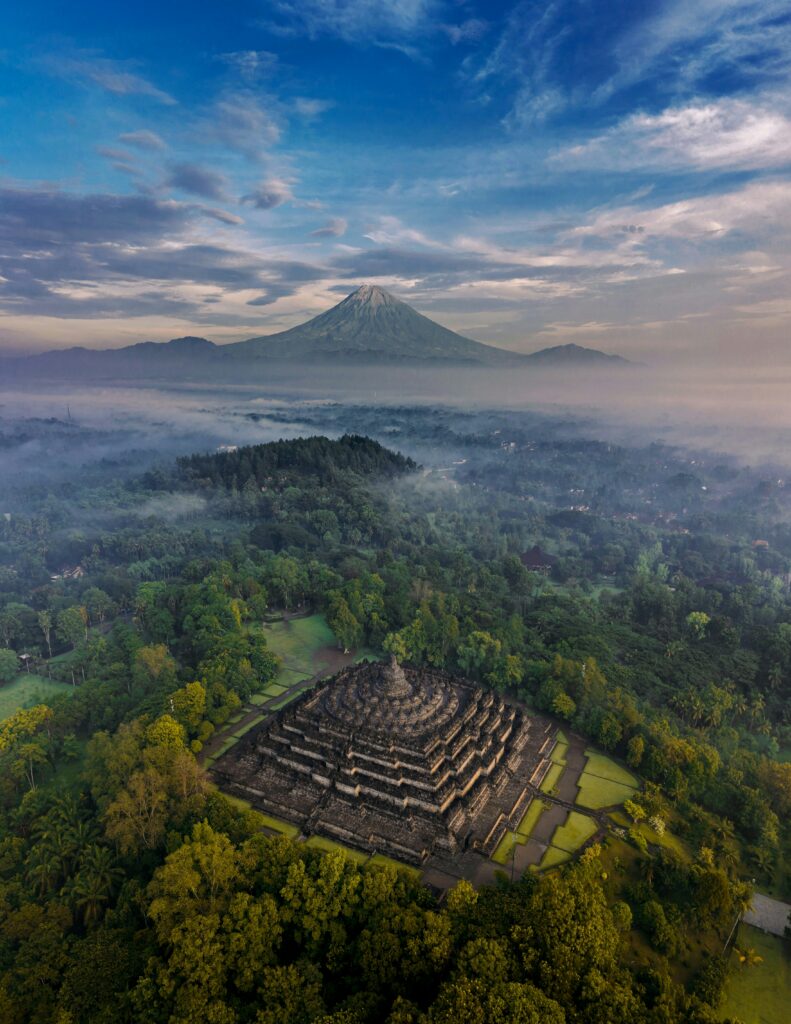
Borobudur is a colossal Buddhist temple complex, recognized as a UNESCO World Heritage Site. Comprising nine stacked platforms adorned with 2,672 relief panels and 504 Buddha statues, it is an architectural masterpiece and the largest Buddhist monument globally.
About Borobudur
The Sailendra dynasty, ruling between 780-840 AD, built this Buddhist relic. This site served as a place of Buddhist worship and pilgrimage, guiding people towards enlightenment and wisdom. British troops, under the leadership of Sir Thomas Stamford Raffles, discovered this relic in 1814, and they cleared the temple area by 1835.
Borobudur, constructed in the Mandala style, mirrors the Buddhist universe. It has a box-shaped structure with four entrances leading to a circular center. Divided into two parts, the outer realm represents worldly existence, while the central realm symbolizes Nirvana.
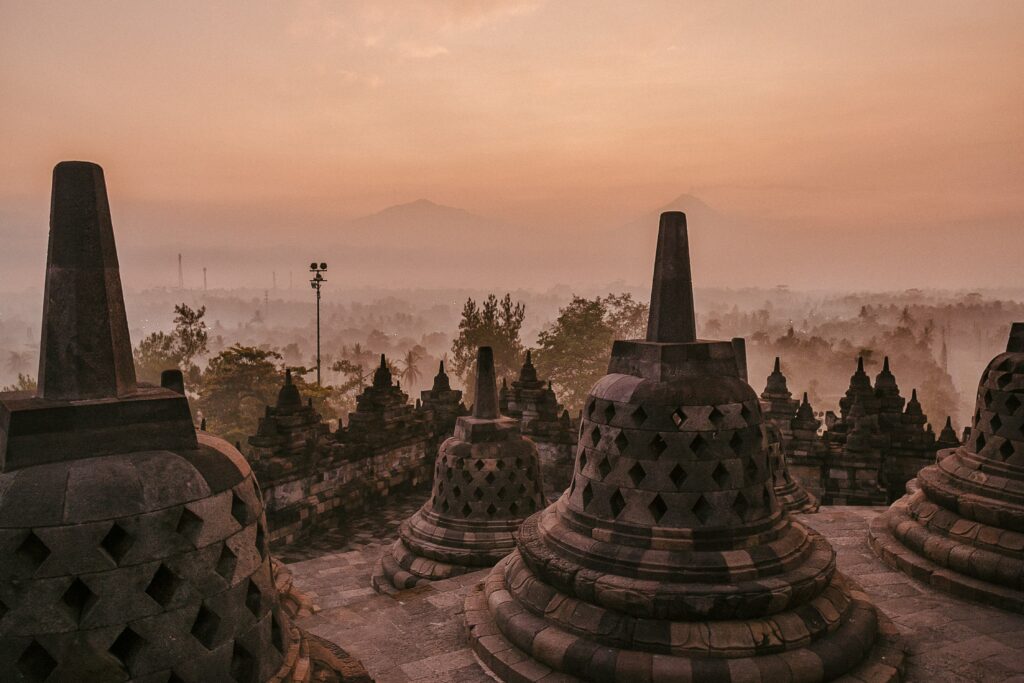
The monument has three divisions, symbolizing the three « realms » of Buddhist cosmology, namely Kamadhatu (the world of desires), Rupadhatu (the world of forms), and Arupadhatu (the formless world).
Zone 1: Kamadhatu (The World of Desires)
This zone is the base of the temple and represents the observable world experienced by humans. Kamadhatu features 160 reliefs illustrating the Karmawibhangga Sutra, depicting the law of cause and effect. These reliefs vividly portray human nature and emotions, including acts such as theft, murder, assault, and slander. The Borobudur Temple Museum displays a collection of 160 relief photos.
Zone 2: Rupadhatu (The World of Forms)
This zone is the body of the temple & showcases a gallery of stone relief carvings and Buddha statues, totaling 328. These statues are adorned with relief decorations and are accompanied by 1300 reliefs, including Gandhawyuha, Lalitawistara, Jataka, and Awadana narratives, covering a distance of 2.5 km with 1212 panels.
Zone 3: Arupadhatu (The Formless World)
It is the top of the temple & features three circular porticoes leading to a central dome or « stupa », representing liberation from worldly attachments. This section is devoid of ornamentation, depicting ultimate purity. The circular porticos contain 72 stupas with inverted bells, housing Buddha statues. The central stupa, though shorter than its original 42m height with a 9.9m diameter, remains empty, sparking debates regarding its contents.
The Borobudur Reliefs
You will see beautiful carvings showing Gautama Buddha’s life at Borobudur. The temple has 2,672 relief panels and there are 504 meditative Buddha statues, each exhibiting six different hand positions.
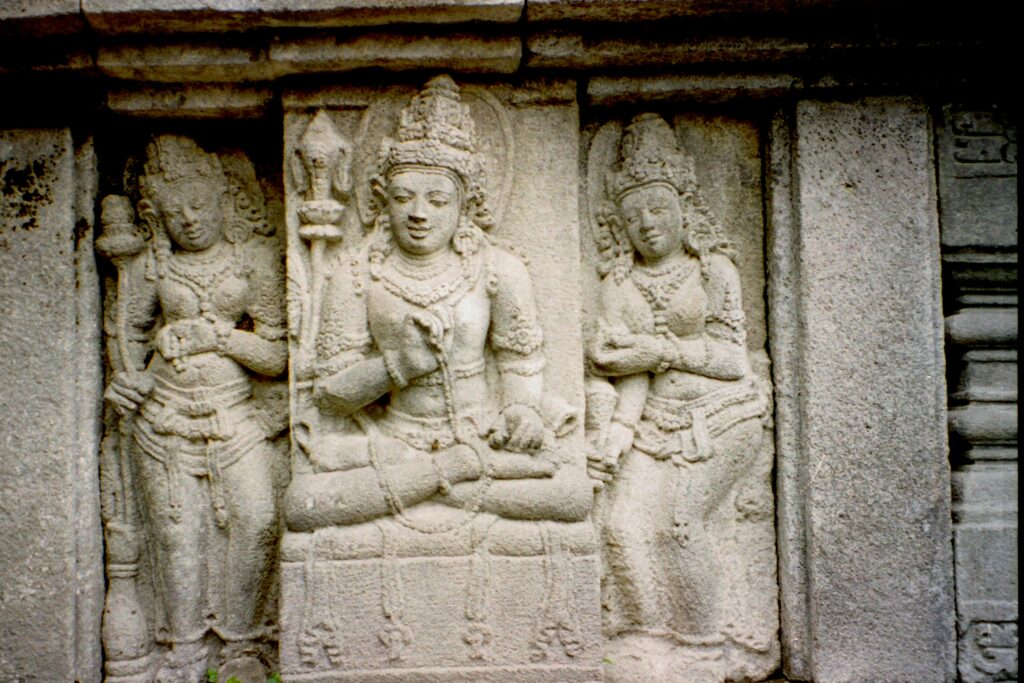
You will also find reliefs of nature, boats, and traditional buildings. Borobudur has the biggest collection of Buddhist carvings worldwide. They’re on almost every level except the highest one. These carvings tell the story of Buddha’s journey to find truth.
Temple Corridor
During the early 20th-century restoration, two smaller temples were discovered around Borobudur: Pawon Temple and Mendut Temple, aligned with Borobudur. Pawon Temple lies 1.15 km away, while Mendut Temple is 3 km away. It’s believed that these temples share a religious connection, yet the exact rituals remain unknown.
These three temples form the route for the Vesak Day Festival, held annually during the full moon in April or May. This festival commemorates the birth, death, and enlightenment of Gautama Buddha.
Borobudur faced years of neglect until restoration efforts began in 1885 under the Dutch colonial government. These efforts aimed to preserve the temple’s grandeur, and over several decades, Borobudur underwent meticulous restoration. Additional rehabilitation work was taken to address volcanic ash damage and ensure the temple’s longevity, following the 2010 eruption of Mount Merapi.
A dedicated team of experts in collaboration with UNESCO and the Indonesian government, executed a comprehensive rehabilitation project. This initiative not only repaired the damages but also incorporated modern technology to monitor and safeguard Borobudur against future natural disasters.
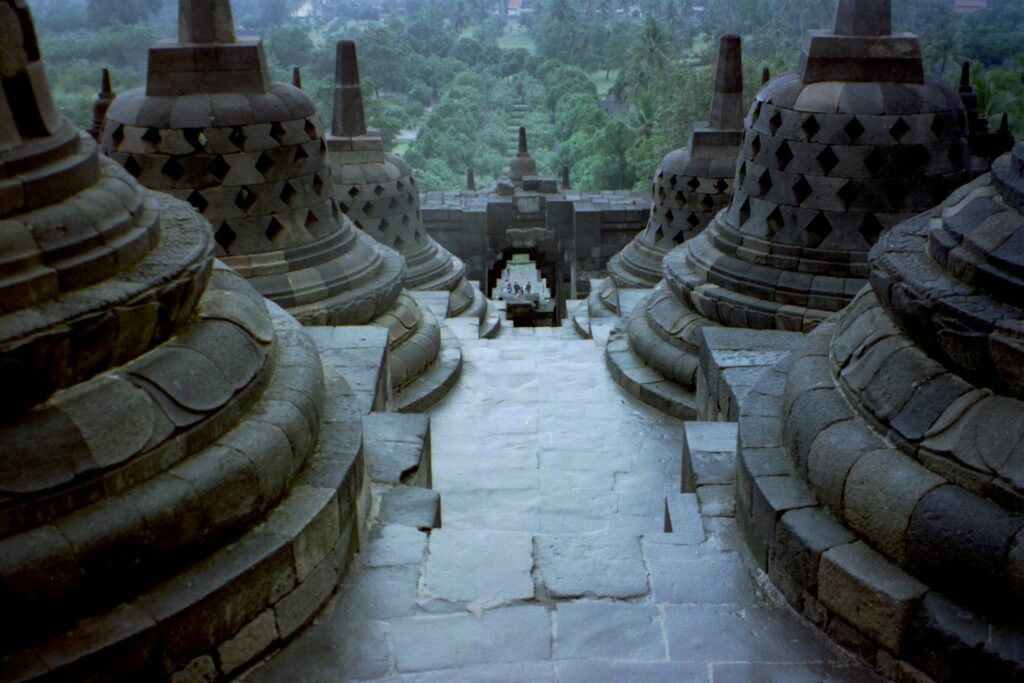
How To Get Here
The best way to get to Borobudur is by renting a private car with a driver or a guide. If you start from Yogyakarta, it will take about 1.5 hour, depending on the traffic. Yogyakarta is the closest city to Borobudur (40km away). You can also get here by using public transport such as Damri Bus from Tugu Train Station or Local Bus from Terminal Bus Giwangan/Jombor.
Looking for a guide or driver during your stay in Yogyakarta? Fill out this form and we will find the best guide for you!
Entrance Fee
It’s one time entrance ticket per person & you can buy it online, following the official website please find below is the entrance fee information:
- Foreign Tourist Entrance Tickets:
- Adult: >10 years old: IDR 455.000
- Child: 3 to 10 years old: IDR 305.000
- Student: IDR 305.000 (with a valid student card)
- Domestic (Indonesian) Tourist Entrance Tickets:
- Adult: >10 years old: IDR 120.000
- Child: 3 to 10 years old: IDR 75.000
Operational Hours
Borobudur Temple is open for visitors from Tuesday to Sunday, from 7 AM to 5 PM. Every Monday, visitors may visit the Borobudur Temple Park area only.
The ticket counter opens at 6.30 AM. The temple has a maximum quota of 1.200 visitors per day. It’s separated into 8 sessions per day with a maximum of 150 visitors in each session.
- Session 1: 09.00 – 10.00 (departure time 08.30)
- Session 2: 10.00 – 11.00 (departure time 09.30)
- Session 3: 11.00 – 12.00 (departure time 10.30)
- Session 4: 12.00 – 13.00 (departure time 11.30)
- Session 5: 13.00 – 14.00 (departure time 12.30)
- Session 6: 14.00 – 15.00 (departure time 13.30)
- Session 7: 15.00 – 16.00 (departure time 14.30)
- Session 8: 16.00 – 17.00 (departure time 15.30)
The most popular times to visit are Session 1-3. The best alternative is Session 7 because the weather is not hot anymore. It is recommended to avoid Sessions 4-5 because of the hot weather. Also, avoid Session 8 because the temple closes at 5 PM, and it takes about 20 minutes to walk from the temple to the exit. It’s not the best time to visit the Borobudur.
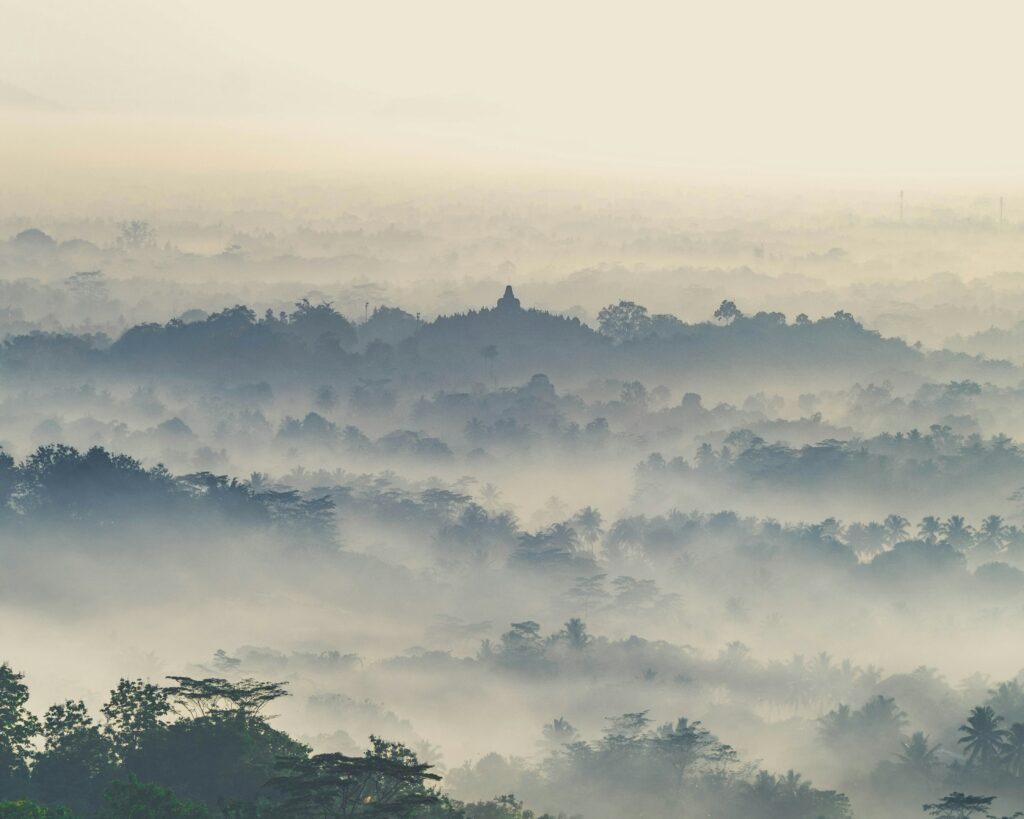
Tips For Visiting Borobudur
- Wear lightweight clothes, comfortable shoes, and a hat.
- Sunscreen is a must, so you will not get sunburn because there is no shade once you’re on the temple structure.
- Stay hydrated, bring a water bottle – though you are not allowed to consume any drinks (or food) at the temple itself.
- Come early morning or late afternoon to avoid crowds and heat.
- Take your time to explore each level and appreciate the carvings.
Looking for a guide or driver during your stay in Yogyakarta? Fill out this form and we will find the best guide for you!
You can also check our tours in Java
Last, but not the least, please be respectful travelers and let the spiritual aura of Borobudur leave an indelible mark on your soul.


